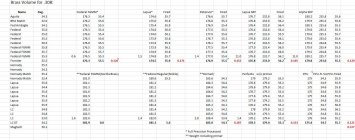So I have ended up with an FX scale.... obviously my OCD has really kicked in with my reloading!
Also with the current shortages and being oppurtunistic I have gotten some random brass. This then begged the question will it perform the same as my Lapua SRP brass.
I ended up with some Peterson and Starline both in SRP configuration.
I began seeking the variances by weighing each style.
Lapua Av weight by grains 171.2 variation 0.2 Neck wall thickness 0.0145 - 0.015
Starline " " " " 172.6 " " 0.6 0.0140 - 0.015
Peterson " " " " 173.9 " " 2.9 0.013 - 0.0135
Not much in it really.
So then I went and dribbled water into them from a syringe and using an eyechometer to check the water level was flat and not concave or convex.
Water capacity of Lapua 55.52 grains
Starline 54.56
Peterson 54.62
Again not much in it so for my purposes I will consider them all even when reloading, I will continue to use the Lapua in my TR rifle and the other brass I will use in an FTR rig I am starting out with.
Here is the question about case capacity
Fired or unfired brass? the reason I ask is that if you measure fired brass shouldnt you also be taking into account the entire chamber out to the lands? As isnt this the true capacity during the detonation phase ?
I opted to measure resized brass as I felt this was more in line for the information I wanted, if the capacities had been of greater variation I would then need to take that into account with charge weights
Also with the current shortages and being oppurtunistic I have gotten some random brass. This then begged the question will it perform the same as my Lapua SRP brass.
I ended up with some Peterson and Starline both in SRP configuration.
I began seeking the variances by weighing each style.
Lapua Av weight by grains 171.2 variation 0.2 Neck wall thickness 0.0145 - 0.015
Starline " " " " 172.6 " " 0.6 0.0140 - 0.015
Peterson " " " " 173.9 " " 2.9 0.013 - 0.0135
Not much in it really.
So then I went and dribbled water into them from a syringe and using an eyechometer to check the water level was flat and not concave or convex.
Water capacity of Lapua 55.52 grains
Starline 54.56
Peterson 54.62
Again not much in it so for my purposes I will consider them all even when reloading, I will continue to use the Lapua in my TR rifle and the other brass I will use in an FTR rig I am starting out with.
Here is the question about case capacity
Fired or unfired brass? the reason I ask is that if you measure fired brass shouldnt you also be taking into account the entire chamber out to the lands? As isnt this the true capacity during the detonation phase ?
I opted to measure resized brass as I felt this was more in line for the information I wanted, if the capacities had been of greater variation I would then need to take that into account with charge weights












